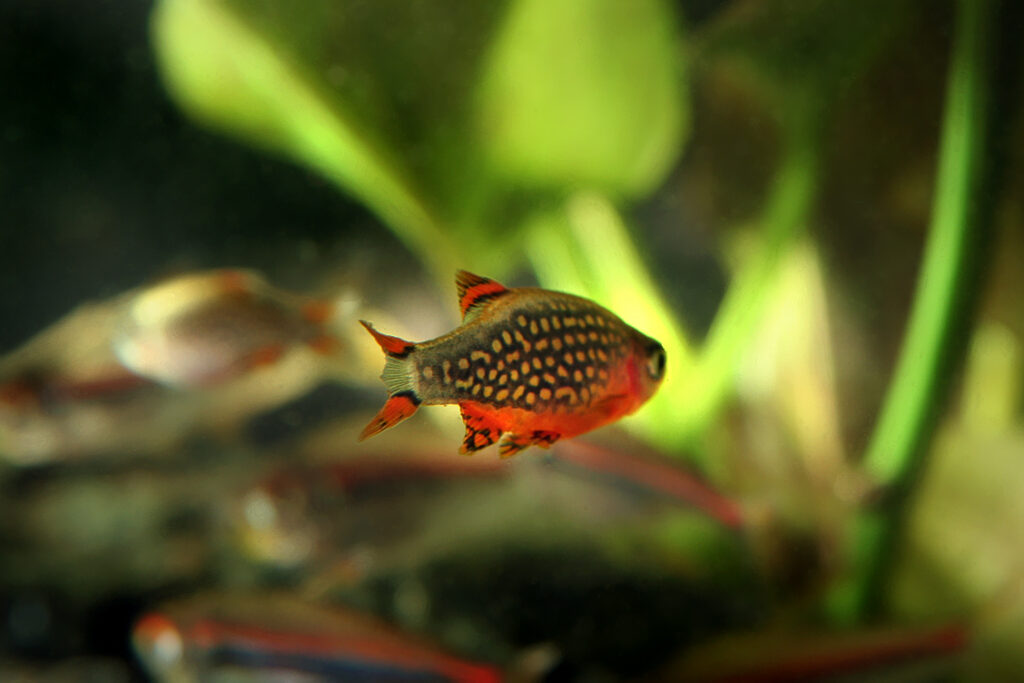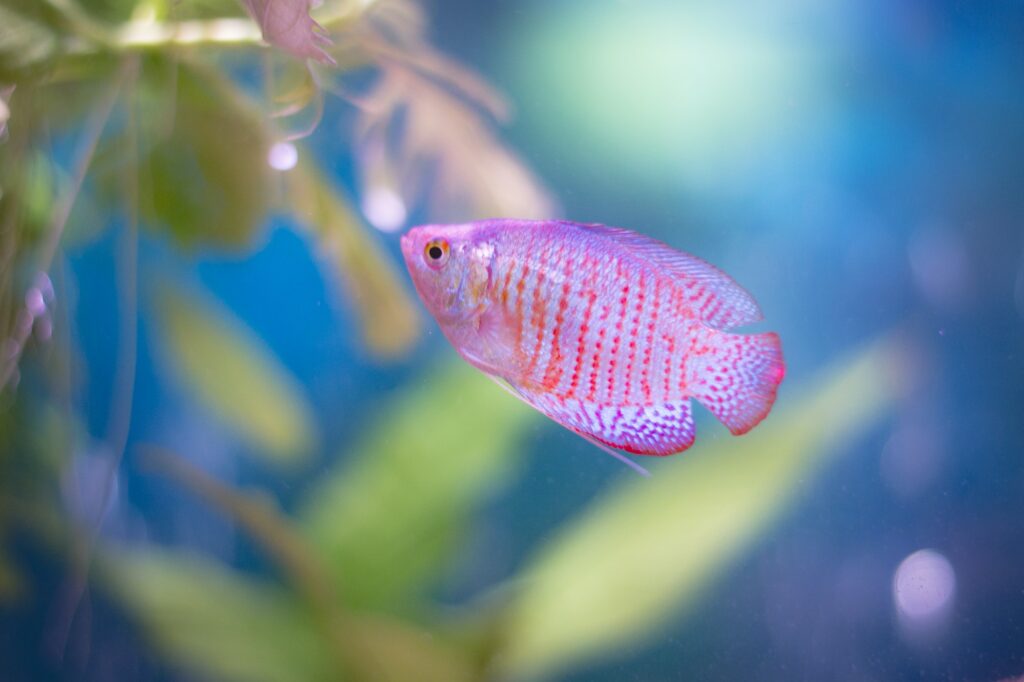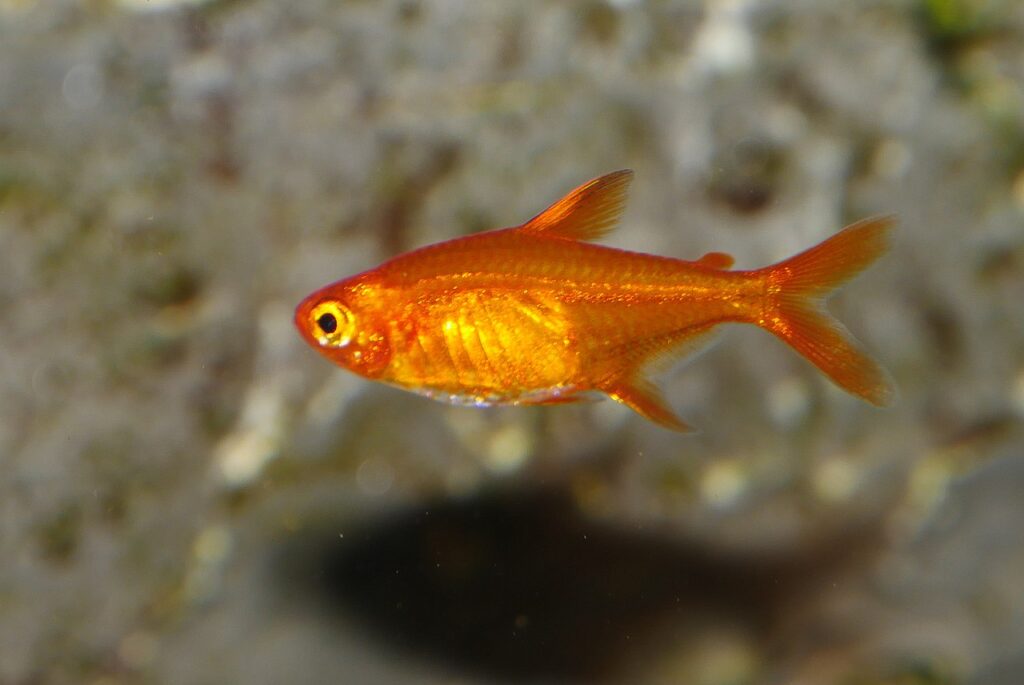Discover the irresistible Zebra Loach (Botia striata), a truly mesmerizing and captivating species that brings life to the magical world of aquariums. With its unique appearance and enchanting behavior, this fascinating fish has captured the admiration of numerous aquarium enthusiasts. Dive into the alluring realm of Zebra Loaches with us as we reveal the secrets of their care, suitable tank companions, and address common inquiries.
Table of Contents
Zebra Loaches belong to the Botiidae family, which is known for its diverse array of loach species. These charismatic fish are native to the streams and rivers of India, where they thrive in the cool, flowing waters. In the aquarium trade, Zebra Loaches are also known by other names such as Candystripe Loach, Striped Loach, and Bengal Loach, adding to their allure and mystique.
One of the most intriguing aspects of Zebra Loaches is their unique appearance. With their elongated bodies adorned with striking black and white stripes, they resemble miniature zebras darting through the aquarium. These bottom-dwelling fish are not only visually appealing but also serve a practical purpose in the tank. As scavengers, they help keep the substrate clean by sifting through the gravel and consuming leftover food particles.
When it comes to their habitat preferences, Zebra Loaches are most comfortable in well-oxygenated waters with a temperature range of 20-26°C (68-79°F) and a pH level between 6.5 and 7.5. They thrive in tanks with plenty of hiding spots, such as driftwood, rocks, and caves, which mimic their natural environment and provide them with a sense of security.
Zebra Loaches are known for their peaceful and social nature, making them excellent tank mates for community aquariums. They get along well with other peaceful fish species, such as Tetras, Rasboras, and Gouramis. However, it’s important to keep them in groups of at least five individuals, as they are schooling fish and enjoy the company of their own kind.
In terms of diet, Zebra Loaches are omnivorous and not particularly fussy eaters. They readily accept a variety of foods, including high-quality flakes, pellets, frozen, and live foods such as brine shrimp and bloodworms. It’s essential to provide them with a well-balanced diet to ensure their optimal health and vitality.
Did you know that Zebra Loaches have a unique defense mechanism? When threatened, they can produce a mild toxin from their skin, which can deter potential predators. This fascinating adaptation highlights the incredible ways in which nature equips these fish for survival.
Throughout history, Zebra Loaches have been a subject of interest for both aquarium enthusiasts and scientific researchers. In fact, a study published in the Journal of Fish Biology in 2012 shed light on the social behavior and hierarchy dynamics within Zebra Loach groups, providing valuable insights into their complex social structures.
As we unravel the mysteries of Zebra Loaches, it becomes clear that these fascinating fish are not only visually stunning but also possess a range of intriguing characteristics that make them a joy to keep in the aquarium. With proper care, a well-designed habitat, and carefully selected tank mates, Zebra Loaches can thrive and bring a touch of natural beauty to your underwater world.

Key Information
The Zebra Loach (Botia striata) is a captivating freshwater fish that showcases a striking pattern of black and white stripes along its elongated body. These contrasting colors create a mesmerizing visual effect, reminiscent of the iconic stripes found on zebras. The intensity and clarity of the stripes may vary slightly among individual fish, adding to their unique charm and appeal.
| Family | Botiidae |
| Origin | India |
| Price | $5 – $10 per fish |
| Common Names | Zebra Loach, Candystripe Loach, Striped Loach, Bengal Loach |
| Variants | None known |
| Ideal Tank Size | 30 gallons or larger |
| Water Parameters | Temperature: 20-26°C (68-79°F), pH: 6.5-7.5, Hardness: 5-12 dGH |
| Lifespan | 8-12 years |
| Full Size | 8-10 cm (3-4 inches) |
| Natural Environment | Streams and rivers with cool, flowing water |
| Behavior | Peaceful, social, bottom-dwelling, schooling |
| Habitat Preference | Well-oxygenated waters with hiding spots (driftwood, rocks, caves) |
| Aquarium Decoration | Provide hiding spots and caves using driftwood, rocks, and plants |
| Ideal Tank Mates | Other peaceful fish (Tetras, Rasboras, Gouramis), invertebrates (shrimp, snails) |
| Fish to Avoid | Large, aggressive fish that may bully or eat Zebra Loaches |
| Best Foods/Diet | Omnivorous; high-quality flakes, pellets, frozen and live foods (brine shrimp, bloodworms) |
| Disease | Susceptible to common freshwater fish diseases if water quality is poor |
| Sex-Switch | No, Zebra Loaches do not change sex |
| Gender Differences | Difficult to distinguish; females may be slightly larger and more rounded when mature |
| Care Level | Easy to moderate; require clean water and a well-maintained aquarium |
| Breeding Level | Moderate to difficult; not commonly bred in home aquariums due to specific requirements (water flow, temperature fluctuations, and specific breeding triggers) |
Ideal Tank Mates
Choosing the right tank mates for Zebra Loaches is essential. It’s important to find species that match their water conditions, behavior, and habitat needs. Zebra Loaches are peaceful and social, thriving when in the company of their own kind and other suitable species. They prefer well-oxygenated water with ample hiding spots and strive in a tranquil, stress-free environment.
To create a harmonious and visually appealing aquarium, it’s important to select tank mates that not only coexist peacefully with Zebra Loaches but also add diversity and interest to the underwater landscape. By carefully choosing compatible species, you can establish a thriving, well-balanced ecosystem where each fish can showcase its unique characteristics and contribute to the overall health and beauty of the aquarium.
Here are 15 ideal tank mates for Zebra Loaches, along with explanations of why they are compatible:
1. Neon Tetras

Neon Tetras are a popular choice for community aquariums due to their peaceful nature and stunning iridescent colors. These small, active fish occupy the middle and upper layers of the tank, providing a beautiful contrast to the bottom-dwelling Zebra Loaches. Neon Tetras have similar water parameter requirements and thrive in planted aquariums, creating a visually appealing and harmonious environment.
2. Harlequin Rasboras

Harlequin Rasboras are another excellent tank mate for Zebra Loaches. These small, colorful fish are known for their active swimming behavior and tight schooling habits. They are peaceful, adaptable, and add a lively presence to the aquarium. Harlequin Rasboras prefer similar water conditions to Zebra Loaches and can help create a dynamic and engaging environment.
3. Cherry Barbs

Cherry Barbs are a vibrant and peaceful species that can coexist harmoniously with Zebra Loaches. These active swimmers have a striking red coloration that adds a pop of color to the aquarium. Cherry Barbs are known for their playful behavior and social nature, making them an entertaining addition to the tank. They share similar water requirements with Zebra Loaches and can thrive in a well-planted aquarium.
4. Kuhli Loaches

Kuhli Loaches are a fascinating and compatible tank mate for Zebra Loaches. These eel-like fish are bottom-dwellers and have a unique, snake-like appearance. Kuhli Loaches are peaceful, nocturnal, and enjoy the company of their own species. They can often be seen weaving through plants and hiding spots, adding an element of intrigue to the aquarium. Kuhli Loaches have similar water preferences to Zebra Loaches and can help keep the substrate clean.
5. Corydoras Catfish

Corydoras Catfish are a beloved choice for community aquariums and make excellent tank mates for Zebra Loaches. These peaceful bottom-dwellers are known for their adorable appearance and energetic behavior. Corydoras Catfish come in a variety of species and colors, allowing you to choose the perfect match for your aquarium. They are hardy, adaptable, and help maintain a clean substrate by scavenging for leftover food.
6. Guppies

Guppies are a classic choice for community aquariums and can live alongside Zebra Loaches without issue. These colorful livebearers are known for their vibrant patterns and active swimming behavior. Guppies occupy the upper layers of the tank, providing visual interest and movement. They are peaceful, hardy, and can adapt to a wide range of water conditions, making them a suitable tank mate for Zebra Loaches.
7. White Cloud Mountain Minnows

White Cloud Mountain Minnows are a peaceful and hardy species that can thrive in the same aquarium as Zebra Loaches. These small, active fish have a silvery-white body with striking red fins, adding a touch of elegance to the tank. White Cloud Mountain Minnows prefer cooler water temperatures, making them an ideal match for Zebra Loaches. They are easy to care for and can help create a balanced and visually appealing aquarium.
8. Platies

Platies are a vibrant and peaceful livebearing species that can coexist harmoniously with Zebra Loaches. These colorful fish come in a wide variety of patterns and colors, allowing you to create a visually stunning aquarium. Platies are active swimmers and occupy the middle and upper layers of the tank. They are hardy, adaptable, and have similar water requirements to Zebra Loaches, making them an excellent tank mate choice.
9. Otocinclus Catfish

Otocinclus Catfish, also known as Otos, are small, peaceful algae-eaters that can live alongside Zebra Loaches. These industrious fish are known for their ability to keep aquarium plants and decor free from algae buildup. Otos are gentle, unobtrusive, and enjoy the company of their own species. They have similar water preferences to Zebra Loaches and can help maintain a clean and healthy aquarium environment.
10. Celestial Pearl Danios

Celestial Pearl Danios, also known as Galaxy Rasboras, are a stunning and peaceful species that can thrive with Zebra Loaches. These small, iridescent fish have a captivating appearance, with a dark body adorned with celestial-like spots. Celestial Pearl Danios are active swimmers and prefer a well-planted aquarium with plenty of hiding spots. They share similar water requirements with Zebra Loaches and add a touch of beauty and elegance to the tank.
11. Dwarf Gouramis

Dwarf Gouramis are a peaceful and colorful species that can live harmoniously with Zebra Loaches. These graceful fish come in a variety of colors and patterns, adding visual interest to the aquarium. Dwarf Gouramis are known for their gentle demeanor and can often be seen leisurely swimming through the tank. They prefer similar water conditions to Zebra Loaches and can thrive in a well-planted aquarium with hiding spots.
12. Ember Tetras

Ember Tetras are a small, peaceful species that can coexist peacefully with Zebra Loaches. These vibrant fish have a striking orange-red coloration that adds a fiery pop of color to the aquarium. Ember Tetras are active swimmers and enjoy the company of their own kind, forming tight schools that create a mesmerizing display. They have similar water preferences to Zebra Loaches and can help create a lively and visually appealing tank.
13. Pygmy Corydoras

Pygmy Corydoras are a miniature version of the popular Corydoras Catfish and make excellent tank mates for Zebra Loaches. These tiny, peaceful bottom-dwellers have an endearing appearance and are known for their active foraging behavior. Pygmy Corydoras enjoy the company of their own species and can often be seen darting around the substrate in search of food. They have similar water requirements to Zebra Loaches and can help keep the tank clean.
14. Endler’s Livebearers

Endler’s Livebearers are a small, colorful species that can live alongside Zebra Loaches without issue. These active fish are known for their vibrant patterns and lively swimming behavior. Endler’s Livebearers are peaceful, hardy, and adapt well to a variety of water conditions. They occupy the upper layers of the tank, providing visual interest and movement. Endler’s Livebearers are a great choice for adding color and life to the aquarium while coexisting peacefully with Zebra Loaches.
15. Bristlenose Plecos

Bristlenose Plecos are a peaceful and hardy species that can thrive alongside Zebra Loaches. These unique catfish are known for their distinctive bristles around their mouth and their exceptional algae-eating abilities. Bristlenose Plecos are gentle giants that spend most of their time grazing on algae and cleaning the tank. They have similar water preferences to Zebra Loaches and can help maintain a clean and balanced aquarium environment.
FAQs
How many Zebra Loaches should I keep in my aquarium?
It is recommended to keep Zebra Loaches in groups of at least five individuals. They are social fish that thrive in the company of their own species, and keeping them in a group helps reduce stress and promotes natural behavior.
Are Zebra Loaches good algae eaters?
While Zebra Loaches are known to graze on some types of algae, they are not primarily considered algae eaters. They are more effective at scavenging for leftover food particles and detritus on the substrate. If you are looking for dedicated algae eaters, consider other species such as Otocinclus Catfish or Bristlenose Plecos.
Can Zebra Loaches live in a planted aquarium?
Yes, Zebra Loaches can thrive in a well-planted aquarium. They appreciate the cover and hiding spots provided by aquatic plants and can coexist peacefully with most plant species. However, be cautious with delicate or fine-leaved plants, as the loaches’ foraging behavior may uproot or damage them.
How often should I feed my Zebra Loaches?
Zebra Loaches should be fed small amounts of food two to three times a day. Offer a variety of high-quality foods, including sinking pellets, frozen or live foods (such as brine shrimp and bloodworms), and occasional vegetable supplements. Avoid overfeeding, as excess food can lead to water quality issues.
Can Zebra Loaches jump out of the aquarium?
Although it is not a common occurrence, Zebra Loaches have been known to jump out of the aquarium if startled or stressed. To prevent this, ensure that your aquarium has a secure, tight-fitting lid or cover. This will not only prevent your loaches from jumping out but also help maintain proper water temperature and reduce evaporation.
How can I tell if my Zebra Loaches are healthy?
Healthy Zebra Loaches should have bright, clear eyes, intact fins, and a plump body. They should be active and display normal swimming behavior, often scavenging along the bottom of the tank. Signs of illness may include lethargy, loss of appetite, visible wounds or abnormalities, and difficulty swimming. If you notice any concerning symptoms, consult a veterinarian specializing in fish care.
Can Zebra Loaches be kept with shrimp or snails?
Zebra Loaches can generally coexist peacefully with larger shrimp species, such as Amano Shrimp or Bamboo Shrimp. However, they may prey on smaller shrimp, like Cherry Shrimp or juvenile shrimp. As for snails, Zebra Loaches are known to consume small snails and may help control snail populations in the aquarium. If you wish to keep ornamental snails, choose larger species that are less likely to be targeted by the loaches.
How can I encourage natural behavior in my Zebra Loaches?
To encourage natural behavior in Zebra Loaches, provide them with a well-decorated aquarium that mimics their natural habitat. Include plenty of hiding spots, such as caves, driftwood, and rocks, where they can explore and seek shelter. Maintain good water quality through regular maintenance and ensure a proper water flow to simulate their native stream environments. Offering a varied diet and keeping them in a group will also help promote natural foraging and social behaviors.